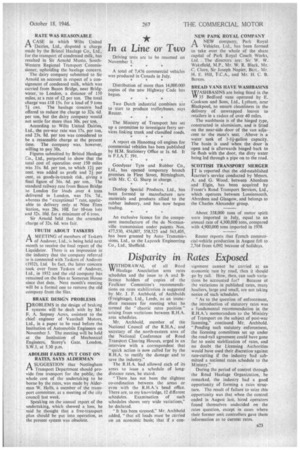Disparity in Rates Exposed
Page 29

If you've noticed an error in this article please click here to report it so we can fix it.
WITHDRAWAL of all Road VY Haulage Association area rates schedules and the issue to A and Blicence holders of copies of the Faulkner Committee's recommendations on rates stabilization is suggested by Mr. J. F. Archbold, of Archbolds (Freightage), Ltd., Leeds, as an immediate measure for meeting what he termed the " chaotic rates position" arising from variations between R.H.A. area schedules.
Mr. Archbold, member of the National Council of the R.H.A., and secretary of the north-eastern area of the National Conference of Road Transport Clearing Houses, urged in an interview with a correspondent that "quick action is now called for by the R.H.A. to rectify the damage and to save the industry."
'the R.H.A. had allowed each of its areas to issue a schedule of longdistance rates, he stated.
"There has not been the slightest co-ordination between the areas or even with the R.H.A.'s head office. 1 here are, to my knowledge, 12 different schedules, Examination of such schedules shows very wide variations," he declared.
It has been stressed," Mr. Archbold added, "that all loads must be carried on an economic basis; that if a con signment cannot be carried at an economic rate by road, then it should go by rail. How, then, can such varia tions be accounted for? Because of the variations in published rates, many hauliers, large and small, are not taking notice of such 'schedules.
"As to the question of enforcement, the introduction of statutory rates was a fundamental recommendation in the R.14.A.'s memorandum to the Ministry of Transport on the subject of post-war licensing," continued Mr. Archbold. "Pending such statutory enforcement, the licensing committees set up under the road-rail agreement could have gone far to assist stabilization of rates, and no doubt the Licensing Authorities would have used their discretion.against rate-cutting if the industry had submitted a national rates schedule to the M inistry."
During the period of control through the Road Haulage Organization, he remarked, the industry had a good opportunity of forming a rates structure. The result of failure to seize this opportunity was that when the control ended in August last, hired operators found themselves undecided on the rates question, except in cases where their former unit controllers gave them information as to current rates.












































































